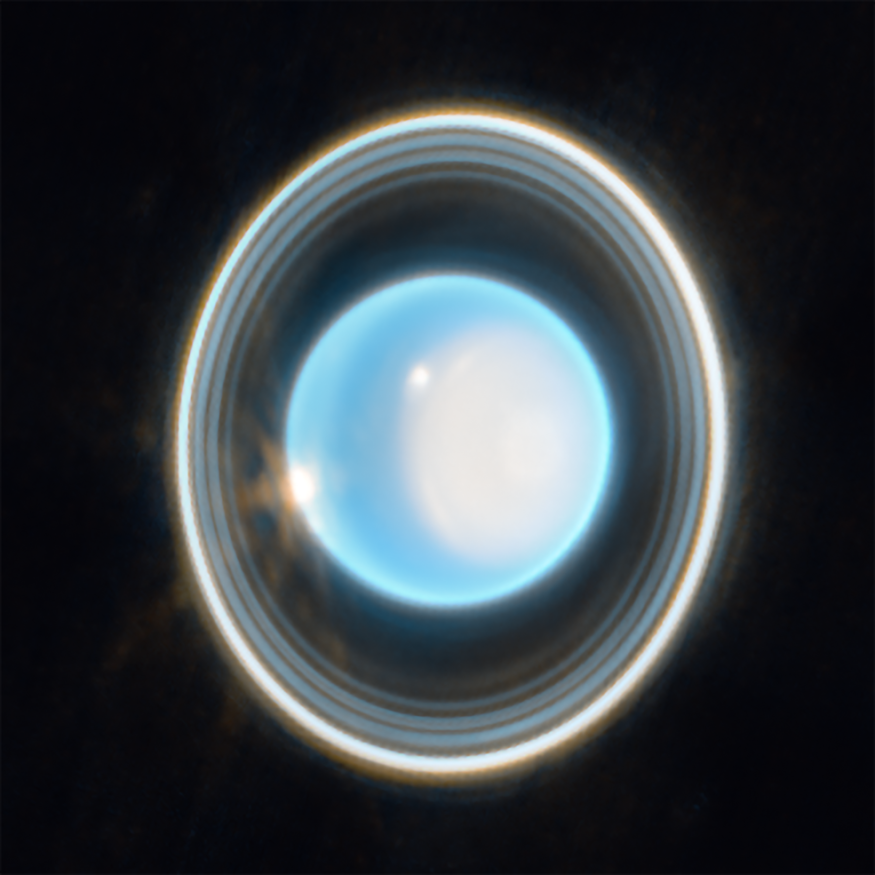For the first time, NASA's James Webb Space Telescope (JWST) has shared its images of the ice giant Uranus with its invisible glowing rings and 27 moons. As per the space agency's press release, the $10 billion space telescope captured 11 of the 13 planetary rings of Uranus that are so bright that they seem to blend in one loop.
The image amazed astronomers as it once again proved the incredible power of JWST. They noted that the two faintest dusty rings were not even discovered until the flyby of Voyager 2.

More Detailed View of Uranus
Uranus is an ice giant planet with a stunning shade of blue caused by the thick haze of the atmosphere, which the University of Oxford researchers call the Aerosol-2 layer that would look whitish at visible wavelengths.
As the seventh planet from the Sun, Uranus appears less bright pictures that resemble the effect of tracing paper on a picture that makes vibrant colors look less vivid.
But JWST's Near-Infrared Camera (NIRCam) captures light from the visible edge of the visible through the near-infrared range of the electromagnetic spectrum that made the new photograph possible. This cutting-edge technology allows the camera to capture distant galaxies with incredible detail, revealing tiny and faint structures that were previously unknown.
The camera captures faint structures including star clusters, which are made up of millions of stars bound together by gravity, forming a stunningly beautiful and complex network. The Near-Infrared Camera has enabled astronomers to take their research to the next level, providing a powerful tool to explore the universe in unprecedented detail.
The European Space Agency (ESA) said that, when Voyager 2 looked at Uranus during its flyby, it only showed a featureless blue-green planet in visible wavelengths. But Webb's infrared-sensitive camera showed a detailed view of the ice giant, which has a dynamic atmosphere.
READ ALSO: Why Is Uranus Weird? 4 Interesting Facts About the Planet That Astronomers Almost Named 'George'
Uranus With Its Rings and Moons
As per MailOnline's report, JWST's image of Uranus showed its unique polar cap that appears during summer when the pole enters direct sunning and then vanishes during fall. The space telescope photographed it as a birth region in the northern part, which can help scientists understand the mysterious mechanism behind it.
Astronomers noted that JWST's sensitivity and longer wavelengths may be the reason for the enhanced polar feature of Uranus, which was not previously observed even by powerful telescopes like NASA's Keck Observatory.
The picture also showed a bright cloud located at the polar cap's edge and another in the southern region, which is typical for the planet and probably linked to storm activity.
ESA stated that this is just a small sample of what the Webb telescope can accomplish when studying this enigmatic planet. More research is currently underway, and Webb's first year of scientific operations will include additional Uranus studies.
NASA scientists have proposed a plan to encourage space agencies to launch a mission to Uranus and Neptune in the 2030s. These two blue planets are shrouded in mystery as the only spacecraft to visit them was Voyager 2 during a fly-by in the 1980s.
The proposed timeline for launching the probes in the 2030s is strategic because of a rare celestial alignment where Jupiter will be perfectly positioned with Uranus and Neptune. The unique alignment will enable the spacecraft to use Jupiter's gravitational force to gain speed and reduce the travel time to reach these outer planets.
RELATED ARTICLE: Scientists Explain Why Ice Giants Uranus and Neptune Have Different Shades of Blue
Read also: Uranus












